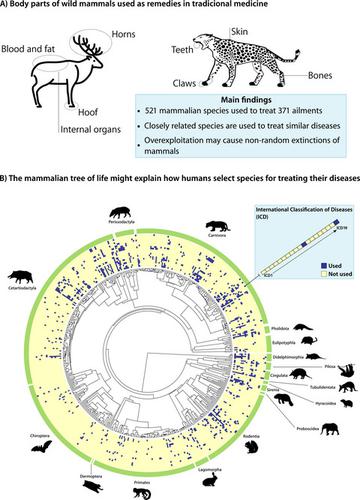当前位置:
X-MOL 学术
›
Mammal Rev.
›
论文详情
Our official English website, www.x-mol.net, welcomes your
feedback! (Note: you will need to create a separate account there.)
A global analysis of ecological and evolutionary drivers of the use of wild mammals in traditional medicine
Mammal Review ( IF 4.3 ) Pub Date : 2020-12-08 , DOI: 10.1111/mam.12233 Rômulo Romeu Nóbrega Alves 1, 2 , Anna Karolina Martins Borges 3, 4 , Raynner Rilke Duarte Barboza 5 , Wedson Medeiros Silva Souto 6 , Thiago Gonçalves‐Souza 7 , Diogo B. Provete 8, 9 , Ulysses Paulino Albuquerque 10
中文翻译:

对在传统医学中使用野生哺乳动物的生态和进化驱动因素的全球分析
更新日期:2020-12-08
Mammal Review ( IF 4.3 ) Pub Date : 2020-12-08 , DOI: 10.1111/mam.12233 Rômulo Romeu Nóbrega Alves 1, 2 , Anna Karolina Martins Borges 3, 4 , Raynner Rilke Duarte Barboza 5 , Wedson Medeiros Silva Souto 6 , Thiago Gonçalves‐Souza 7 , Diogo B. Provete 8, 9 , Ulysses Paulino Albuquerque 10
Affiliation

|
- Ingredients derived from wild mammals are widely used in traditional remedies. Large datasets of traits, geographic ranges, and phylogeny are also available for mammals. Therefore, mammals are an ideal group in which to explore the ecological (e.g. range size, body mass) and evolutionary (i.e. shared ancestry) correlates of the use of animal‐derived products in traditional medicine.
- In a global analysis of correlates of the use of wild mammals in traditional medicine, we tested how life‐history traits relate to the use of mammal products to treat disease. We compiled data from the primary literature about folk remedies based on mammals via a literature search using ISI Web of Knowledge, Scopus, and Google Scholar. Then, we used modern phylogenetic comparative methods to estimate phylogenetic signals in the diseases that mammal body parts are used to treat and to test whether geographic range size and body mass are related to medicinal use. We tested whether mammalian species that are used more in medicine are also those that are more threatened by extinction.
- Our results show that 521 mammalian species are used to source products to treat 371 ailments. We found support for the hypothesis that phylogenetic relatedness correlates with the use of mammal‐derived remedies in traditional medicines. Specifically, we confirm our hypotheses that closely related species are more similar in terms of their perceived medical versatility than distantly related species and are used to treat similar diseases. Furthermore, we demonstrated that large marsupials are more versatile and are used to treat more diseases than smaller marsupials.
- In our database, 155 mammalian species are considered threatened (Vulnerable, Endangered, or Critically Endangered), and a further 46 are Near Threatened, suggesting that overexploitation for medicinal use could be an overlooked source of threat that should be considered in mammal species conservation assessments. We demonstrate that phylogenetic relatedness correlates with the use of mammalian species as remedies in traditional medicine, and urge future researchers to evaluate the negative effects of overexploitation of mammals for medical purposes. Such overexploitation could cause non‐random extinction patterns in the mammalian tree of life.
中文翻译:

对在传统医学中使用野生哺乳动物的生态和进化驱动因素的全球分析
- 源自野生哺乳动物的成分被广泛用于传统疗法中。性状,地理范围和系统发育的大型数据集也可用于哺乳动物。因此,哺乳动物是探索在传统医学中使用动物衍生产品的生态(例如范围大小,体重)和进化(即共同祖先)相关性的理想群体。
- 在对传统医学中野生哺乳动物使用相关性的全球分析中,我们测试了生命历史特征与哺乳动物产品用于治疗疾病的关系。我们使用ISI Web of Knowledge,Scopus和Google Scholar通过文献搜索,从原始文献中收集了有关基于哺乳动物的民间疗法的数据。然后,我们使用了现代的系统发育比较方法来评估哺乳动物身体部位用于治疗的疾病的系统发育信号,并测试地理范围的大小和体重是否与药物使用有关。我们测试了在医学上使用更多的哺乳动物物种是否也更容易受到灭绝的威胁。
- 我们的结果表明,有521种哺乳动物被用来采购产品以治疗371种疾病。我们发现系统进化相关性与传统医学中哺乳动物衍生疗法的使用相关的假说得到了支持。具体而言,我们证实了以下假设:就亲密关系而言,密切相关的物种比远距离相关的物种更具相似性,并被用于治疗相似的疾病。此外,我们证明了大型有袋动物比小型有袋动物更具通用性,可用于治疗更多的疾病。
- 在我们的数据库中,认为有155种哺乳动物受到威胁(易危,濒危或极度濒危),另有46种受到濒危威胁,这表明药用过度开发可能是一种被忽略的威胁源,应在哺乳动物物种保护评估中予以考虑。我们证明了系统发育的相关性与使用哺乳动物作为传统医学的疗法相关,并敦促未来的研究人员评估出于医学目的对哺乳动物过度开发的负面影响。这种过度开发可能会在哺乳动物的生命树中造成非随机的灭绝模式。











































 京公网安备 11010802027423号
京公网安备 11010802027423号